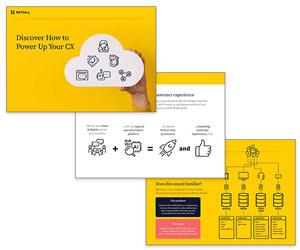In this post we answer the question ‘what comes next?’ as technology rapidly advances to keep up with a new breed of connected consumer.
Age of the experience centre (2020 and beyond)
As more connected devices come on the market, the volume of customer data is exploding. To keep up with customer demands, the contact centre of the future will rely heavily on chatbots and artificial intelligence (AI).
Although chatbots have existed for many decades, they’re yet to truly change the way consumers interact with contact centres. But this is all be about to change as the likes of IDC and Microsoft predict AI will redefine the customer experience in the next ten years. Intelligent assistants, such as Amazon’s Alexa, Microsoft’s Cortana and Apple’s Siri, are already making rapid advances in this area and becoming more familiar to mainstream consumers.
Despite the hype around AI, the history of chatbots indicates that there is still some way to go until robots can complement agents effectively. Microsoft’s failed Tay project demonstrates the risks of rushing in new technology. Furthermore, these technologies are unlikely to replace agents entirely, since complex or emotional interactions will always require human contact. Instead, we will probably see agents and robots working in harmony to assist customers.
The adoption of these new technologies will also depend on the extent that businesses embrace innovation. New technologies have to overcome so many teething problems before they enter the mainstream, and few businesses are willing to gamble on a new technology if there are question marks over its security credentials, its ability to improve services, or whether it will deliver real value.
What we’ve learned from the journey
Contact centre leaders have always followed behind consumer demand. They constantly play catch-up, progressively adding speech recognition, email, webchat, SMS callback and social media solutions in response to new customer expectations. However, many of these emerging channels and technologies are not yet fully integrated with core contact centre voice solutions.
This lack of strategic direction and careful integration may be due to a focus on contact centres as cost centres rather than as a crucial way to improve the customer experience as a whole. Low cost labour has made it cheaper to hire more agents than invest in technologies that will really enhance and improve services.
With AI and the IoT now firmly on the horizon, contact centres have an opportunity to roadmap the adoption of new channels and technologies in advance of customer demand. To thrive in a future led by automation and personalisation, contact centres need to embrace a new paradigm – replacing a reactive focus on customer expectations by boldly and proactively seizing emerging digital opportunities.
An exceptional contact centre experience will increasingly become a competitive differentiator and new technologies are the key to making this a reality. The customer may always be right, but businesses will need to unleash desired innovations before consumers even know they want them to stay at the vanguard of contact centre innovation.
For more information on this topic, download our report.
Author: Guest Author
Published On: 19th Jul 2017 - Last modified: 6th Dec 2024
Read more about - Archived Content, Netcall







































